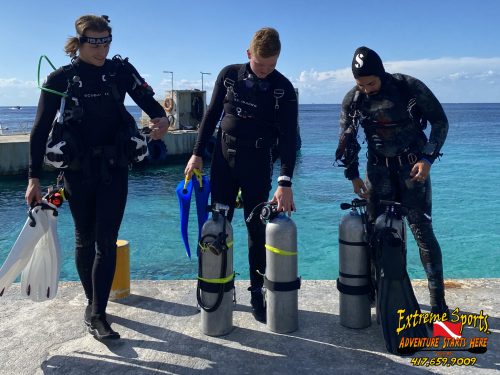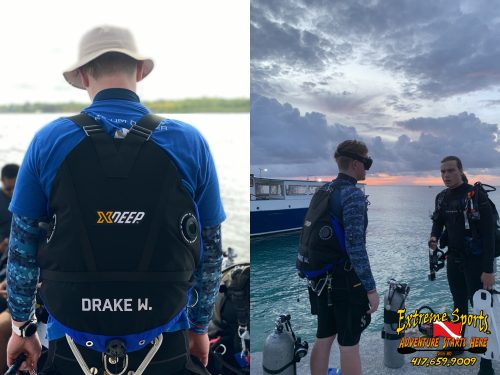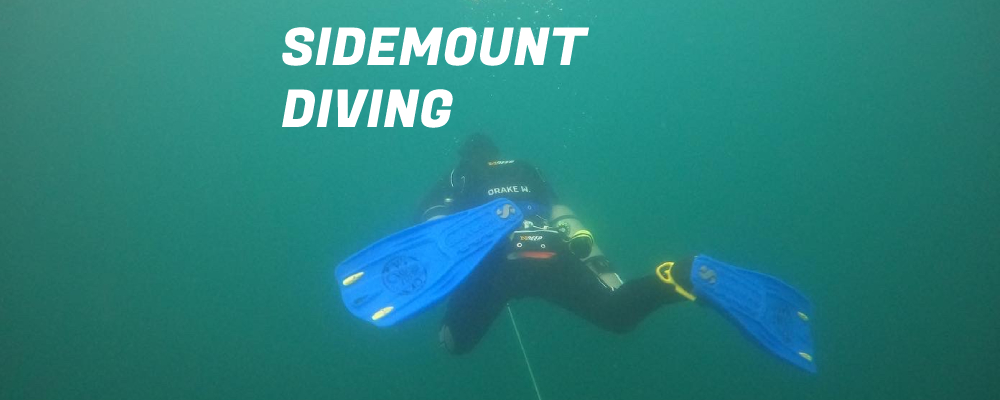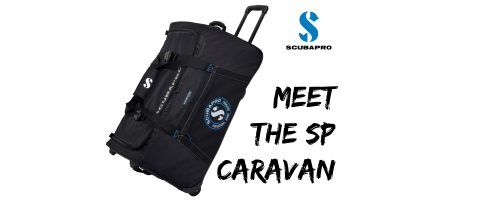One of the worst feelings during a dive is running out of air (or nitrox) before others OR simply having to end a dive due to low volume when the NDL still says 50. Sidemount diving, in the recreational side, is simply to allow divers to carry more volume of air in a more streamlined configuration. In this article, we will discuss:
What is sidemount?
The benefits and drawbacks of sidemount.
When I prefer sidemount diving / when I do not.
What it takes to be a SDI Sidemount Diver
Sidemount diving originated from cave diving in the late 1960’s. In early development, it was self-taught only to technical cave divers. However, recently it has been introduced into recreational diving – for two main reasons. To allow recreational divers that are interested in technical diving, ‘try’ it before committing towards it, and to allow recreational divers to use sidemount for it’s benefits (within recreational limits).
What is Sidemount
Sidemount is simply explained in the name. This is any dive that involves the use of one or more cylinders mounted to the side of the diver. Each cylinder mounted contains a first stage, a second stage, an SPG, and an LPI hose (if applicable). The early ‘rigs’ were actually homemade units, until 2005 when the first sidemount system became available to purchase.
The sidemount harness is not the traditional BCD or backplate/wing that we are used to. Those systems are referred to as back-mount diving. For example, I dive with an XDEEP Stealth 2.0 Tec system. The X-Deep harness and wing, manufactured in Poland, wraps around my body creating a streamlined system. One thing is guaranteed with sidemount diving, everyone will be asking questions about your gear.
Knowing that sidemount diving came after backmount, what did cave divers do before sidemount? You guessed it, they removed their whole backmounted-doubles and passed their gear through tight bedding planes (tight limestone boundaries in caves). In sidemount diving, divers are able to ‘sling’ or ‘shotgun’ their cylinders forward to go into tighter spots.
I know, I know. Maybe you’re not the diver who would ever dare to do technical diving – and you’re probably right, most don’t. So let’s talk about the benefits of sidemount diving in the recreational side.

the benefits of sidemount
– Redundant gas supply: If a sidemount diver were to loose all the air in one cylinder, they still have another cylinder for redundancy.
– Ease of managing failed equipment: By having the cylinders mounted to the side, the diver is able to easily turn valves off. This is especially useful when needing to ‘feather’ a regulator or shutdown a unit for a hose failure.
– Reduced weight (out of the water): Many prefer walking down to their dive site in sidemount compared to backmount – as that weight isn’t on your back. Carrying sidemount cylinders is no different than carrying a normal cylinder. When donning sidemount, it is much easier to do this in the water! Sidemount cylinders are also handled individually.
– Low profile design: The vertical distance of a backmount diver compared to a sidemount diver is almost double! This allows sidemount divers to get into places where a backmount diver could never. This lower profile also reduces drag in the water allowing the diver to be more efficient in their kicking and air consumption.
– Educational advantage: Sidemount divers learn a lot of information about the physics of weighting, cylinder placements, types of cylinder use, and bladder positioning in the water. This not only allows the diver to be more comforatble in the water in sidemount, but even in backmount. Sidemount divers learn a TON about gear and the right gear throughout the duration of their instruction.
– Personalization: Many sidemount systems are on standard 2″ webbing. This creates an amazing range of personalization up to the diver! If a diver needs a longer shoulder loop, simply loosen it up. Maybe a canister light sounds like a great option, slide the D-Rings off and attach the canister!
Check out this video below:
the drawbacks of sidemount
– Complexity: Coming directly from cave diving and technical diving, sidemount is a more ‘gear intensive’ way of diving. It involves a completley new way of learning hose routing, donning the gear, doffing the gear, out of air emergencies, and cylinder attachments.
– Gas management: In backmount, we hop in the water and dive; once we meet our reserve, we surface. Sidemount divers switch between gasses throughout the dive to keep the volumes in the cylinders fairly equal.
– Low profile design: Once a benefit, could be a drawback. In narrow passages, sidemount might not be the best option.
When I Prefer Sidemount Diving / When I Do Not
Personally, I dive half of my dives in backmount, and half in sidemount. One of the main reasons I would choose backmount over sidemount would be for training. I will always be in the same configuration as my students. Another reason would be not to complicate things. Boat diving sometimes can be an easier option, so I will choose my backmount BCD.
There is a term in diving that should be used in EVERY aspect: KISS – Keep It Stupid Simple… or as some say: Keep It Simple, Stupid! That’s my go-to’ term when deciding what gear to dive with. If I don’t need it, I don’t bring it.
On the other side, if I was able to dive sidemount more often, I defiantly would! Just like the benefits say, sidemount offers a redundant air source! When performing a deep dive, I would prefer to have more volume of air for redundancy. For new sidemount divers, I suggest taking the SDI Solo Diver course to learn about redundancy and being more self aware. This creates a great foundation for sidemount diving and even into technical diving (if that’s your thing).
What it Takes to be a Sidemount Diver
#1 – Commitment – Being a specialty, which is more gear intensive, it seems to push some new sidemount divers away. Simply staying committed to the sidemount system will push those divers to customize it and really enjoy the system more than they thought.
#2 Diving often – Just like stated above, it is more gear intensive, which means being familiar with the gear. By not diving for long periods of time in sidemount, divers might lose the feeling for diving in sidemount and/or get confused with the proper setup and configuration. To simply say it: go dive!
#3 Proper training – A sidemount certification is easily achievable, but it will take time through myself. Countless of hours will be spent training both online, in person, at the pool, and the lake. Being comfortable in sidemount is one of the hardest things to overcome for new sidemountees’. Customizing the gear for the divers personal fit is one of the most important steps some instructors skip out on.
#4 Proper gear – All sidemount systems are not the same (ask us how we know). Regulator systems are required to be in DIN (meaning the cylinders as well). SPGs or transmitters are allowed to be used, and of course a legible wrist computer is a must. With diving with more volume, sidemount divers can ‘use up’ more of their No-Decompression-Limits, meaning a computer in which the diver can see is a must (consoles can not be used).
#5 Mental focus and willingness to learn – Again, with more gear attached, it requires the diver to think about what they are doing and what their gas volumes are… the whole time. Being setup completely different than normal, your willingness to learn and adapt to new ways of stowing gear, proper procedures for safety, and tips and tricks to make sidemount diving enjoyable must be open!
#6 High comfort levels – For our course, we like our sidemount divers to have plenty of experience diving in the lakes, as this is where we will be performing our training.

what are your next steps?
If you are interested in taking the SDI Sidemount Diver course here at Extreme Sports, simply stop by or call us! The course starts out with eLearning to cover the basic information needed prior to in-person training. Click the link below to learn more information about the course:
other blog posts:
Selecting the Right SCUBA Mask
it’s just important! What is the most important piece of...
Read MoreTop Gifts for Scuba Divers
Our List Scuba divers always have a need for something...
Read More1st Stage Turrets – Why?
Jumping back in history Looking back in time at Scubapro’s...
Read MoreMeet the Scubapro Caravan Bag
before the caravan Through out the years I have traveled...
Read More



